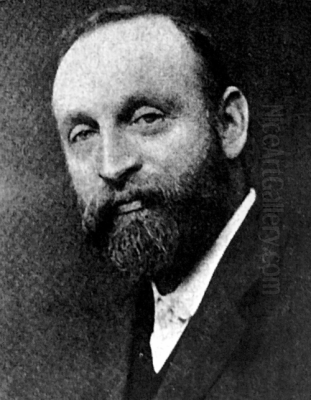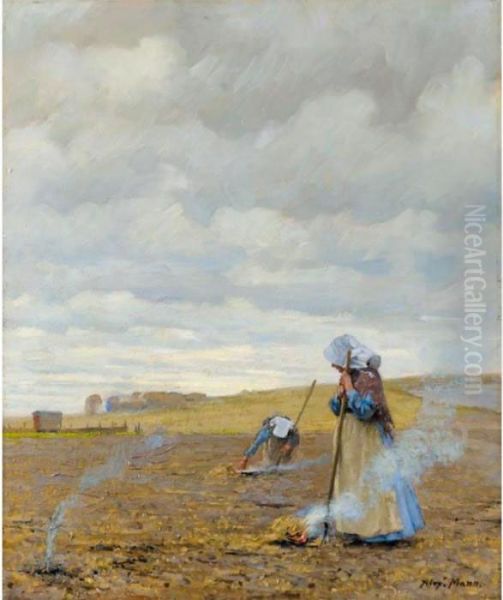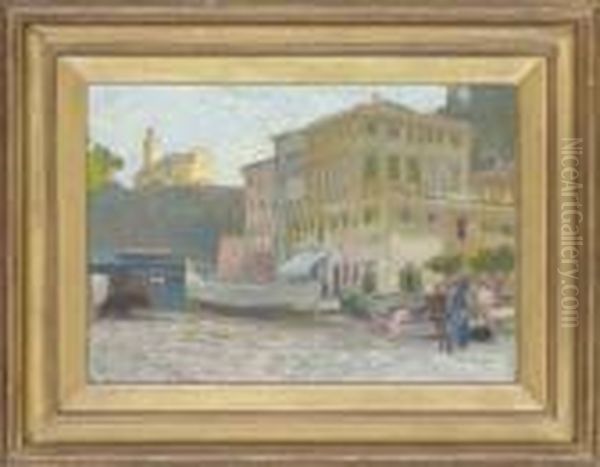
Alexander Mann (1853-1908) stands as a significant figure in late 19th and early 20th-century Scottish art. Born in Glasgow and concluding his life in London, Mann navigated the complex artistic currents of his time, establishing himself primarily as a painter of landscapes and genre scenes. His work is particularly notable for its engagement with emerging artistic trends, positioning him as an early adopter of Post-Impressionist sensibilities and demonstrating a keen, forward-looking interest in the medium of photography. His artistic journey took him from the industrial heart of Scotland to the vibrant art capital of Paris, shaping a career that bridged traditional practices with modern explorations.
Early Life and Artistic Beginnings in Glasgow
Alexander Mann was born in Glasgow on January 22, 1853. His father, James Mann, was a successful merchant and notably, a collector, suggesting an environment where art was appreciated. This familial background likely fostered Mann's own artistic inclinations from a young age. His formal artistic education began in his native city under the tutelage of the painter Robert Greenlees, a respected figure associated with the Glasgow School of Art. Mann further honed his skills by attending evening classes at the Glasgow School of Art itself, immersing himself in the foundational techniques of drawing and painting within the city's burgeoning artistic community.
These formative years in Glasgow provided Mann with a solid grounding in academic principles. Robert Greenlees, known for his role in art education in the city, would have imparted essential skills. The Glasgow School of Art, even in its earlier phases, was becoming a crucible for Scottish talent, fostering an environment where traditional training met with a growing awareness of contemporary European art movements. This initial training set the stage for Mann's later, more advanced studies abroad.
Parisian Influence and Development

Seeking to broaden his artistic horizons, Alexander Mann made the pivotal decision to move to Paris in 1877. This move placed him at the epicenter of the art world during a period of intense innovation and stylistic debate. He enrolled at the prestigious Académie Julian, a private art school renowned for attracting international students and offering an alternative to the more rigid École des Beaux-Arts. The Académie Julian was a melting pot of artistic ideas, known for instructors like William-Adolphe Bouguereau and Jules Lefebvre, though Mann's specific teachers there were different.
Following his time at the Académie Julian, Mann sought further refinement under the guidance of prominent artists. He studied initially with Mihály Munkácsy, a Hungarian painter celebrated for his dramatic historical and genre scenes, known for his rich, dark palette and vigorous brushwork. Subsequently, from approximately 1881 to 1885, Mann became a pupil of Carolus-Duran. A highly successful portraitist and figure painter, Carolus-Duran encouraged a direct, painterly approach influenced by masters like Velázquez, attracting students such as the famed American expatriate John Singer Sargent. This period of Parisian study was crucial, exposing Mann to diverse technical approaches and the prevailing artistic philosophies of the time, from lingering academicism to the rising tides of Realism and Impressionism.
Artistic Style: Naturalism, Post-Impressionism, and Photography
Alexander Mann's artistic output reflects the diverse influences he absorbed. Primarily recognized as a landscape and genre painter, his style evolved throughout his career. An early influence evident in his work is Naturalism, particularly associated with the French painter Jules Bastien-Lepage. This is clearly seen in Mann's oil painting Burning Weeds, which depicts a rural scene with the detailed observation and focus on peasant life characteristic of Bastien-Lepage's popular style. The work captures a specific moment of agricultural labour with an objective, yet sensitive eye.
However, Mann was more than just a follower of established trends. He is identified as an early adopter of Post-Impressionism in Britain. This suggests a move beyond the purely objective recording of nature towards a more subjective or structured approach, although the specifics of his Post-Impressionist leanings (like heightened colour or formal simplification found in artists like Van Gogh or Gauguin) require examination on a work-by-work basis. His membership in the New English Art Club (NEAC), founded in 1886 as a progressive alternative to the Royal Academy, places him alongside other forward-thinking British artists like Walter Sickert and Philip Wilson Steer. He was also a member of the Royal Institute of Oil Painters (ROI).

Perhaps the most distinctive aspect of Mann's artistic identity was his profound interest in photography. This fascination manifested notably in his 1884 work, Gnats and other hindrances to the successful accomplishment of landscape painting. This publication, containing etchings and artist's sketches, not only humorously addressed the practical challenges faced by plein-air painters but also demonstrated a sophisticated awareness of photographic seeing. Art historians suggest this work reveals Mann's sensitivity to photographic framing and sequencing, even hinting at a nascent understanding of cinematic narrative – a remarkable insight for the time. This engagement with photography distinguishes him, showing an artist grappling with the implications of new visual technologies for traditional art forms.
Mann's style, therefore, represents a fascinating confluence: the detailed observation of Naturalism, the burgeoning subjectivity of Post-Impressionism, and a unique, early engagement with the principles of photography. He sought to capture the realities of landscape and rural life while simultaneously exploring new modes of visual expression influenced by both painterly tradition and technological innovation.
Representative Works
Several key works help illuminate Alexander Mann's artistic practice and reception:
Gnats and other hindrances to the successful accomplishment of landscape painting (1884): This collection of etchings and sketches is arguably one of Mann's most intellectually significant contributions. Published early in his mature career, it showcases his wit and his deep engagement with the process of landscape painting. More importantly, it serves as crucial evidence of his early interest in photography and its potential relationship to narrative and composition in the visual arts. It marks him as an artist thinking critically about representation across different media.
A Bead-Stringer, Venice (c. 1884): This genre painting earned Mann an Honourable Mention at the prestigious Paris Salon in 1884. Receiving recognition at the Salon was a significant achievement for any artist, especially a foreign one, indicating the quality and appeal of his work to the Parisian art establishment at the time. The subject suggests a focus on everyday life captured during his travels, likely rendered with the careful observation characteristic of his training.
Burning Weeds (date uncertain, exhibited 2012/2021): This oil painting, measuring approximately 61 x 51 cm, exemplifies Mann's connection to the Naturalist movement, particularly the influence of Jules Bastien-Lepage. Depicting a rural scene, likely featuring figures engaged in the task of burning weeds, it showcases a commitment to realistic portrayal. The painting bears Mann's signature and his studio address at 53 Glebe Place, Chelsea, London. Its provenance includes acquisition via Sotheby's Gleneagles in September 2004 and a notable sale at Cheffins' auction house in Cambridge in July 2021 for £53,000 (including premium).
TANGI (1892): This oil painting surfaced at auction at The Fine Art Society in London in December 1984. Estimated at £800-£1,200, it sold for £1,100. The title might suggest a theme related to Maori culture (a tangi is a Maori funeral ceremony), indicating Mann potentially travelled or engaged with ethnographic subjects, though further information on this specific work is limited in the provided context. Its auction record provides a snapshot of his market value in the mid-1980s.
Portofino (1906): Painted late in his career, this oil on canvas measures 10¼ x 14 inches (26 x 35.5 cm). It is inscribed "Portofino / Oct 1906" on the reverse, clearly dating and locating its creation to the Italian Riviera. This work was exhibited at The Fine Art Society in London in March 1991 (catalogue no. 36) and subsequently entered a private collection. As a later work, it might reflect developments in his style, possibly incorporating brighter colours or looser brushwork influenced by ongoing Post-Impressionist trends, applied to a sunlit Mediterranean landscape.
These works collectively illustrate Mann's range, from detailed Naturalist scenes and Venetian genre subjects to his innovative graphic work and later landscape paintings. They also track his professional recognition, from Salon honours to his presence in the London gallery and auction markets.
Contemporaries and Context
Alexander Mann operated within a rich network of artistic relationships and influences. His direct teachers form a crucial part of his story: Robert Greenlees in Glasgow provided his foundation, while Mihály Munkácsy and Carolus-Duran in Paris offered advanced, albeit different, approaches to figure and genre painting during a critical developmental phase. The influence of Jules Bastien-Lepage, though perhaps not a direct teacher, was profound on Mann's Naturalist works like Burning Weeds, aligning him with a major trend in European art of the late 1870s and early 1880s.
While the provided information doesn't detail specific friendships or direct collaborations Mann had with fellow students at the Académie Julian or in the studios of Munkácsy and Carolus-Duran, his presence in Paris placed him in proximity to countless artists. Studying under Carolus-Duran, for instance, meant he was in the same pedagogical lineage as John Singer Sargent, though their paths may not have directly crossed significantly.
His involvement with the New English Art Club (NEAC) in London connected him organizationally with key figures of British Impressionism and Post-Impressionism, such as Walter Sickert and Philip Wilson Steer. This membership signifies his alignment with the progressive wing of the British art scene, seeking new avenues for exhibition and artistic expression outside the confines of the Royal Academy.
In Scotland, while Mann's career trajectory differed from the core group known as the 'Glasgow Boys' (like James Guthrie or John Lavery, who also often studied in Paris but developed a distinct collective identity focused on rural realism and impressionistic light), he was part of the same generation of Scottish artists seeking international training and recognition. His unique focus on photography, however, sets his explorations apart somewhat from his Scottish contemporaries.
Contextualizing his Post-Impressionist leanings requires acknowledging the broader European movement. While Mann was an "early adopter," the term Post-Impressionism broadly encompasses the diverse innovations of artists like Vincent van Gogh, Paul Gauguin, Georges Seurat, and Paul Cézanne, who were pushing beyond Impressionism in various ways during the 1880s and 1890s. Mann's contribution lies in his specific blend of painterly concerns with an unusually early and insightful engagement with photographic vision.
Later Life and Legacy
Alexander Mann continued to paint and exhibit throughout his career. His later works, such as the 1906 painting Portofino, show him continuing to engage with landscape painting, possibly reflecting the brighter palettes and looser handling characteristic of early 20th-century art. He maintained a studio in Chelsea, London, a popular area for artists at the time, as indicated by the address on the back of Burning Weeds.
His life concluded in London on January 26, 1908, just four days after his 55th birthday. While perhaps not as widely known today as some of his contemporaries in the NEAC or the Glasgow Boys, Alexander Mann holds a distinct place in British art history. His legacy rests on his competent and sensitive handling of landscape and genre subjects, reflecting key influences like Naturalism.
More significantly, his importance lies in his position as a bridge figure. He absorbed Parisian training and participated in the progressive art movements of his time in Britain. Crucially, his documented interest in photography, particularly the thoughtful exploration evident in Gnats, marks him as a forward-thinking artist, presciently aware of the dialogue emerging between painting and the new mechanical means of image-making. His works continue to appear on the art market, as evidenced by auction records at respected houses like The Fine Art Society and Cheffins', indicating a sustained collector interest in his contribution to Scottish and British art. Alexander Mann remains a figure worthy of attention for his skillful painting and his insightful early engagement with the visual culture of modernity.